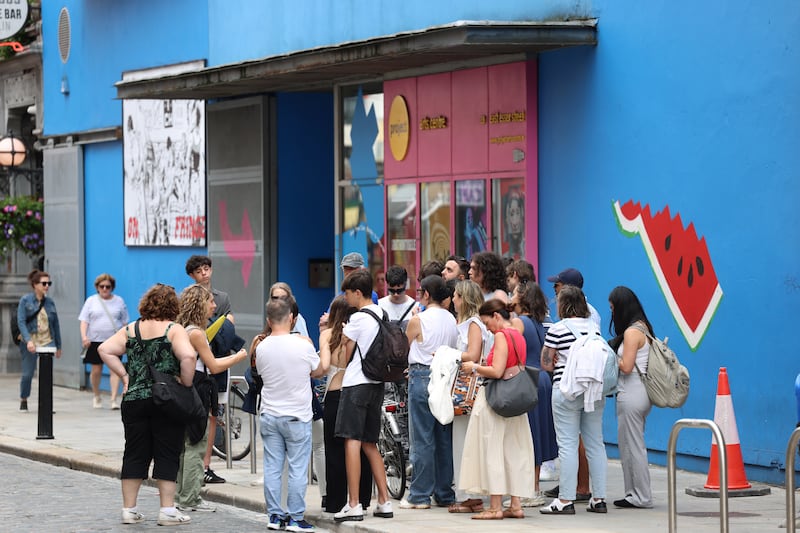Ask any Dubliner where to go for pricey pints, tourist tat, and the type of “traditional Irish” establishment they would never themselves frequent, and they’ll happily give directions to Temple Bar. Ask them to point towards Dublin’s cultural quarter, however, and they are likely to be a bit nonplussed.
Temple Bar has, since its inception, been promoted as the city’s cultural quarter, but most would agree it has strayed considerably from that vision.
The origins of the present-day Temple Bar lie in a plan devised 50 years ago by CIÉ to develop a new central bus station for the city. From the mid-1970s the company began to buy up buildings, and the many derelict sites, in the area between Dame Street and the south Liffey quays with a view to levelling them for the new transport hub.
Government funding was slow to follow the transport company’s scheme, so with admirable fiscal rectitude CIÉ rented out the properties (those not in use as surface car parks at least) at low rents to Dublin’s “bohemian” set – artists, musicians and independent retailers – and in doing so sowed the seeds of the demise of its bus garage plans.
RM Block
Taoiseach Charles Haughey saw an urban development opportunity, far beyond what had grown organically, and threw CIÉ under the bus, so to speak. He envisioned a district of “attractive small places” with “recording studios, places for the music industry, art galleries, studios” and also “pubs, restaurants, discos – anything that contributes to a lively inner city young people’s place”.
An urban renewal act and a tax incentive scheme came into force in 1991, a development company – Temple Bar Properties – was established, and Temple Bar was born.

It didn’t take long before property prices began to rise, as they did across the city in the 1990s, and for the more lucrative enterprises – pubs, night clubs, hotels and restaurants, to start pushing out the artists and smaller independent operators.
By end of the decade it had become a byword for hedonism, even targeted in 2001 by a Channel 4 documentary series of the type that focused on the bad behaviour of “Brits abroad”, though generally in sunnier climes.
In part to counteract this image, the Noughties saw a definite shift in emphasis in the development of Temple Bar from growth to management, with Temple Bar Properties becoming the Temple Bar Cultural Trust in 2005. However, within a few years that entity had run into difficulties, with several reports and audits identifying financial, governance and regulatory weaknesses. In 2013 a decision was made to dissolve the trust and transfer its functions to Dublin City Council.

In 2016 the council published a public realm plan to improve the area, which resulted in not very much for quite a long time, but eventually in 2023 led to a €5 million upgrade of Temple Bar Square, the focal point of the eastern end of Temple Bar.
The year 2016 also saw a significant intervention in the fight against overtourism in the district, spearheaded not by the council but by Temple Bar residents who sought a ruling on whether or not planning permission was required to use an apartment for holiday rentals. The council planners determined it was required, a ruling upheld by An Bord Pleanála. This ultimately led to a city-wide and then State-wide crackdown on the unauthorised use of homes for short-term letting, and while that battle goes on, it would never have started without the intervention of those residents.

The council has in recent years upped its game in efforts to rein in the worst excesses of Temple Bar, using the planning process. The 2022-2028 city development plan includes a number of provisions to guard against the expansion of pubs and takeaways, and to avoid the concentration of the types of shops which would “reinforce particular activities in the area to the detriment of the cultural, residential and social functions of the area”.
A number of planning applications have been refused by the council since these provisions were introduced, though some of these decisions have been overturned on appeal to An Bord Pleanála.
The council has, in the last two years, increased the number of artists’ studios in Temple Bar and plans to refurbish the long-closed Eden restaurant in Meeting House Square to provide more. It is also in the process of taking ownership of the historic Smock Alley Theatre at the western end of Temple Bar to create a new Dublin municipal theatre.

Perhaps the council’s most significant physical intervention in Temple Bar is its most recent: the removal of traffic from Parliament Street since July 4th, which is likely to attract more activity, from the eastern end of the district.
Some in the quieter west end may have misgivings over what may be drawn upon them. The image of Temple Bar has been severely tarnished by several violent assaults – on tourists, as well as on two off-duty gardaí. The stark depiction by Judge Pauline Codd, at an assault sentencing hearing last year, said Temple Bar was becoming a “a violent post-apocalyptic place”. “It’s shocking to see it, that people can’t be safe down there. It makes it a no-go area for people.”


Martin Harte, chief executive of business group the Temple Bar Company, says dystopian assessments are not fair characterisations of the area.
“I think a lot of the criticism and the view or positioning of Temple Bar comes from the late 1990s and early Noughties and that massive, mad drink culture. It was true then, there were queues outside every pub and hotel; it certainly isn’t true now,” Harte says.
He argues that there is an overconcentration of addiction and homeless services throughout the city centre. However, he believes the district is moving closer to the original vision of a cultural, entertainment area, but also a residential quarter.
“Certainly in last couple of years the vintage clothes shops are back, the tattoo parlours, the cafes, the cultural collectives, the private galleries – they’ve really come back. Of course some have been lost, but a huge amount have come, and Temple Bar has a thriving cultural scene. I think it’s probably going to get closer to what people thought it might be in the first place. I think its best years are ahead of it,” Harte says.























